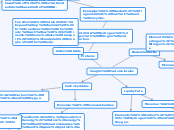by cate vaughn 7 years ago
322
Vaughn Macromolecules

by cate vaughn 7 years ago
322

More like this
https://www.youtube.com/watch?v=0lZRAShqft0
Unique characteristics: Determine the inherited genes of every living being and they are called acids because they are proton (i.e., hydrogen atom) donors, and therefore they carry a negative charge.
Examples: RNA and DNA
Unique characteristics: primary structure is made up of amino acids and the sequence is based off of the nucleotide bases of DNA.
https://www.youtube.com/watch?v=EweuU2fEgjw
https://www.youtube.com/watch?v=_ExVXeovB6s
Unique characteristics: lipids cannot dissolve in water and they store energy. Unsaturated fats have some double bonds and saturated fats have no double bonds
Unique characteristics: Is a chain of sugar molecules in a simple form and provide fast energy.
https://www.youtube.com/watch?v=mUo4c2f9rpI
Examples: Sugars, starches, cellulose, and glycogen.
Subtopic